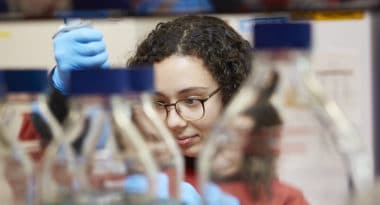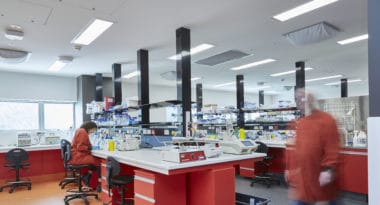
The Roman Group is investigating how cells communicate to establish organ architecture and function. We use the skeletal muscle cell as a model to study cell-cell interactions by focusing on specialized regions such as the neuromuscular junction or the stem cell niche. Combining microscopy, tissue engineering and spatial genomics, we can monitor intercellular signals with high spatiotemporal resolution during development or homeostasis and observe how these are affected in diseases and ageing. The lab aims to identify fundamental principles of intercellular communication as well as translational discoveries to improve muscle disorders and ageing.
Click here to visit the Roman Group website

Contact us (william.roman@monash.edu) to find out about Honours and PhD opportunities with the Roman group.
Group Members





Research Themes
- Skeletal muscle cell biology, regeneration, and repair.
- Tissue bioengineering of skeletal muscle organs using iPSCs and microfabrication.
- Intra- and intercellular communication from cell behaviour to genomic response.

Featured Publications
| Authors | Title | Published In |
|---|---|---|
Roman W, Pinheiro H, Oliveira L, García-Domínguez E, Gómez-Cabrera MC, Serrano AL, Gomes ER, Muñoz-Cánoves P. |
Muscle repair after physiological damage relies on nuclear migration for cellular reconstruction. |
Science. 2021 Oct 15. Vol. 374, No. 6565. doi: 10.1126/science.abe5620 |
Roman W, Martins JP, Gomes ER. |
Local arrangement of fibronectin by myofibroblasts governs peripheral nuclear positioning in muscle cells. |
Developmental cell. 2018 Jul 2;46(1):102-111.e6. doi:10.1016/j.devcel.2018.05.031 |
Roman W, Martins JP, Filomena AC, Voituriez R, Abella VG, Santos NC, Cadot B, Way M, Gomes ER. |
Myofibril contraction and cross-linking drive nuclear movement to the periphery of skeletal muscle. |
Nature Cell Biology, 2017 Oct;19(10):1189-1201. doi: 10.1038/ncb3605. |
More Publications
| Authors | Title | Published In |
|---|---|---|
Roman W and Muñoz-Cánoves P. |
Muscle is a stage, and cells and factors are merely players |
Trends in Cell Biology. 2022 April 1. 1:S0962-8924(22)00061-7. doi: 10.1016/j.tcb.2022.03.001 |
Pinheiro H, Pimentel MR, Sequeira C, Oliveira LM, Pezzarossa A, Roman W, Gomes ER. |
mRNA distribution in skeletal muscle is associated with mRNA size. |
J Cell Sci. 2021 Jul 15;134(14):jcs256388. doi: 10.1242/jcs.256388. |
Brunet T, Albert M, Roman W, Coyle MC, Spitzer DC, King N. |
A flagellate-to-amoeboid switch in the closest living relatives of animals. |
Elife. 2021 Jan 15;10:e61037. doi: 10.7554/eLife.61037. |
Roman W, Pimentel MR, Gomes ER. |
An In Vitro System to Measure the Positioning, Stiffness, and Rupture of the Nucleus in Skeletal Muscle. |
Methods in Molecular Biology, 2018 Aug;1840:283-293. doi: 10.1007/978-1-4939-8691-0_19. Methods |
Roman W, Gomes ER. |
Nuclear positioning in skeletal muscle. |
Seminars in Cell and Development Biology, 2017 Dec 11. S1084-9521(17)30428-7. Review. |
Falcone S*, Roman W*, Hnia K, Gache V, Didier N, Lainé J, Auradé F, Marty I, Nishino I, Charlet-Berguerand N, Romero NB, Marazzi G, Sassoon D, Laporte J, Gomes ER. |
N-WASP is required for Amphiphysin-2/BIN1-dependent nuclear positioning and triad organization in skeletal muscle and is involved in the pathophysiology of centronuclear myopathy. |
EMBO Mol Med. 2014 Sep 28;6(11):1455-75. doi: 10.15252/emmm.201404436. |



